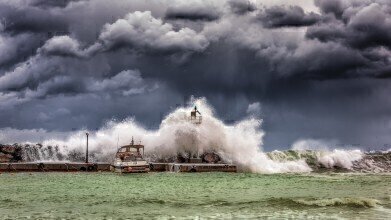Environmental Laboratory
Is it Possible to Build a Tsunami-Proof Building?
Jul 15 2015
The mammoth tsunami which devastated Indonesia, Thailand, Sri Lanka and India (among other countries) in 2004 demonstrated the widespread destruction and death that huge tidal waves can cause. Indeed, as the deadliest tsunami on record, the disaster claimed the lives of well over 220,000 people and laid waste to countless buildings and towns.
Predicting Disaster Before it Strikes
As a result, scientists, technicians and architects have placed a greater emphasis on trying to reduce the havoc caused by such phenomenon. One approach to this is to attempt to predict the onslaught of an imminent tsunami using weather pattern monitoring, as is explained in more depth in this cautionary article by Gary A Noakes. By understanding the effect that global warming is having on our planet and using this information to predict meteorological anomalies, we can hopefully reduce the damage done by tsunamis by acting pre-emptively.
In fact, as recently as last year great strides were made in this field, as a critical final link for the Phillippines' tsunami warning system was provided by a UK company. For more information on the specifics of the warning system, how it works and how it is being employed in other tsunami-threatened regions, check out the above article.
Building Tsunami-Proof Buildings
Another approach to the problem is to prepare for any worst case scenario by equipping current buildings with the ability to withstand the effects of a tsunami. Of course, the sheer force of the waves involved in the 2004 event meant that many houses and buildings were decimated – but we are able to learn much about structural integrity from those that remained.
The ideal tsunami-proof building would rely on several different aspects. These include:
- Location. If possible, edifices should be kept as far back from the shoreline as possible. Building on canals or inlets is especially inadvisable, since these can channel the water and increase its force.
- Surrounding land features. Rough terrain reduces waves’ momentum and slows it down. Therefore, vegetation should be allowed to grow freely – mangrove swamps are particularly effective at counteracting tsunami force.
- Materials. Though wood is a preferred material in constructing earthquake-proof buildings, it is perhaps the worst choice in a tsunami situation since it is easily uprooted and can cause further damage to other buildings. Reinforced steel and concrete combined is a better option.
- Elevation. A suspended floor which allows water to go under the building as well as around it will greatly reduce the effect of the tsunami.
- Positioning. If possible, the building should be side on to the shoreline, so that any approaching wave will not impact the wall face-on and at full force. Diagonal building is ideal.
Of course, all of these measures cannot guarantee that any building will withstand the sometimes immense and overwhelming power of nature. However, adhering to these guidelines will ensure the building has the best possible chance of surviving the effect of even the strongest tidal wave.
Digital Edition
IET 34.2 March 2024
April 2024
Gas Detection - Biogas batch fermentation system for laboratory use with automatic gas analysis in real time Water/Wastewater - Upcycling sensors for sustainable nature management - Prist...
View all digital editions
Events
May 13 2024 Munich, Germany
May 15 2024 Lund, Sweden
May 15 2024 Frankurt-am-Main, Germany
May 20 2024 Columbus, OH, USA
May 21 2024 Lagos, Nigeria


















